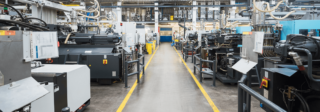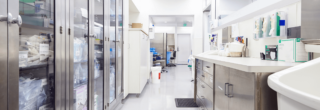Refrigeration Temperature Monitoring
Maximizing efficiencies with remote temperature controls and monitoring
Refrigeration Temperature Monitoring
In the food and restaurant industry, accurate temp monitoring is vital. The federal government issues temperature guidelines for food storage and safety, which is overseen by health and safety inspectors. Fines for non-compliance can be steep and organizations face forced closure for repeated infractions. Public safety is an important consideration. According to the Centers for Disease Control (CDC), food spoilage causes illness in 48 million people every year in the United States. Though this is a number that combines instances stemming from restaurants as well as the groceries we purchase from a store, it’s clear that adequate temperature control plays a part in loss mitigation.
However, human monitoring is often unreliable. Even the most diligent workers overlook temperature details at times, and for a high-cost product, that translates to significant potential loss. Wireless temp sensors allow operators to monitor conditions remotely. Sensors issue real-time alerts, notifying stakeholders of temperature anomalies in time to avert spoilage.
Restaurants that have a lot of money tied up in wine inventory can also benefit from remote temp sensors. When storing high-value wines, both temperature and humidity must remain consistent, or degradation can happen. Sudden temperature spikes can quickly render some wines undrinkable, leading to unrecoverable losses and an increase in the cost of doing business.
In an industry with a notoriously tight margin, every dollar counts, and temp sensors are an excellent way for the food and beverage industry to preserve profits, maintain product quality, and satisfy health and safety compliance mandates.
Maximizing Efficiencies with Temperature Controls
In today’s highly competitive business landscape, maximizing efficiency is critical. From the factory floor to the customer’s door and throughout the supply chain, ensuring your products arrive on time and as expected is essential to customer retention – and profitability.
IoT is a major catalyst in this effort, as it provides a newfound ability for the enterprise to monitor everything from machine function to logistics. Such visibility enables companies to make just-in-time business decisions, streamline processes, and delight customers at scale. While this might seem like a complicated undertaking, the technology is highly accessible and cost-effective, opening new avenues for risk reduction and a greater level of control over just about every process.
Pharmacies Can Use Wireless Temperature Sensors for Drug Storage
Temperature Control and Pharmaceutical Drug Storage
Most medications need to be stored in a dry, dark and cool place. High temperatures can chemically alter medications, while high moisture can cause tablets to degrade. Most prescription medications are stored in one of four types of conditions:
- Room temperature: Most medications are designed to be stable at room temperature, so this is a common storage requirement. Room temperature for pharmaceuticals is defined as 20 to 25 degrees Celsius or 68 to 77 degrees Fahrenheit.
- Cool storage: Cool storage conditions are defined as 8 to 15 degrees Celsius or 46 to 59 degrees Fahrenheit.
- Cold storage: Cold storage is considered 2 to 8 degrees Celsius or 36 to 46 degrees Fahrenheit. These conditions are optimal for inhibiting chemical reactions and microbial growth. Cold storage is often required for highly degradable drugs and vitamins.
- Fridge storage: Fridge storage is another common pharmaceutical storage requirement and is defined as -4 to 2 degrees Celsius or 25 to 36 degrees Fahrenheit.
Many manufactures recommend discarding medications if they are stored outside their recommended temperature range for five hours or more. Exposure to higher temperatures can result in the active chemicals in medications changing at a molecular level. Sometimes, this can result in the medication decomposing, making it less potent or even changing its effects. Medications known to be affected by temperatures include injectable diabetes treatments, eye-drop medications, inhaled drugs, birth control and various antibiotics. Degraded medications can be life-altering or life-threatening, so they must be stored properly.
Best Practices for Pharmaceutical Drug Storage
It’s easy for individuals to expose their medications to heat and humidity accidentally — a hot car ride or an open bathroom medicine cabinet is often all it takes. But heat exposure can also occur in a pharmacy. Power outages, heatwaves and malfunctioning equipment can all result in heat exposure within a pharmacy building and destroy pharmaceutical supplies. To protect against temperature exposure, pharmacies can employ a few best practices:
- Packaging: Ensure medications are packaged properly, complete with suitable coverings and seals. Avoid opening new packages unless necessary and double-check that containers are adequately sealed when not in use.
- Airflow: Proper airflow can help dissipate heat within a pharmacy. To this end, take advantage of windows and air vents. Make sure screens are installed to prevent bugs from entering the pharmacy and leave windows open when possible. Try to circulate this airflow as much as possible using fans.
- Placement: Tightly packed boxes and shelves can trap heat, causing medications to overheat over time. Place shelves and boxes in the pharmacy so there is enough room for air to flow between them.
- Air conditioning: Always ensure your pharmacy has a functioning air conditioner available to handle particularly hot days. Schedule regular maintenance for your air conditioning system to ensure it is properly functioning at all times.
On top of these best practices, implementing a temperature monitoring system can help ensure that medications are stored at proper temperatures.
The Role of Temperature Monitoring Systems
Monitoring temperatures and conditions manually is a common method for maintaining pharmacy room temperature range. This manual recording can be inconsistent or inaccurate. It is also limited to working hours when someone is present in the pharmacy to record temperatures. As an alternative, many pharmacies have turned to automated temperature monitoring systems.
Temperature monitoring systems use wireless sensors to record environmental conditions in a space. Using a wireless network, these sensors can monitor the temperature in a pharmacy storage area, sending records to a database. Some systems can also measure humidity. The system sends automated alerts when a space’s measurements fall outside set thresholds so someone can quickly come and resolve the problem before medications are negatively affected.
Radio Bridge, a MultiTech brand, offers a range of temperature monitoring sensors that can be used in pharmacies. Based on LoRaWAN® wireless technology, these sensors provide wireless penetration through walls and floors and have excellent range. They can also be configured remotely. If measurements fall above or below preset thresholds, the sensors use the system to send out an alert.


